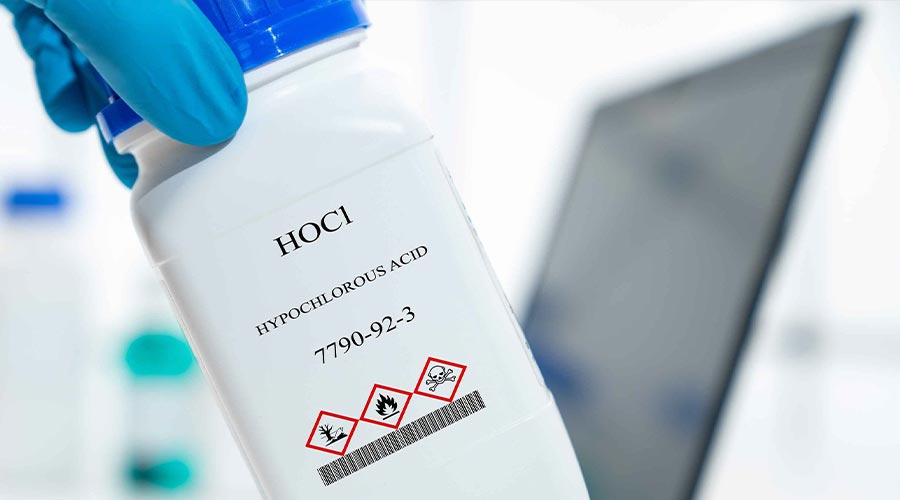
Contributed by Phil Carrizales, ACME Paper & Supply Co.
Imagine cleaning and disinfecting an entire facility with just water. Impossible? Think again.
Electrochemically activated water (ECA water), also known as hypochlorous acid or HOCL is produced with just water, salt, and electricity. This seemingly simple process yields a powerful disinfectant with a wide range of applications across various industries.
The Science Behind HOCL
Hypochlorous acid, a free chlorine molecule, is produced through the electrolysis of water and sodium chloride. Despite its name, the acidity of HOCL is comparable to that of citrus fruits like lemons, with a pH range of 5.5 to 6.5. Notably, HOCL is naturally produced by the white blood cells of mammals to kill microbial pathogens in the body. In nature, HOCL penetrates bacterial cell walls, rendering the bacteria ineffective.
Widely appreciated as a disinfectant because of its oxidizing properties, HOCL can tackle bacteria and viruses alike, including COVID-19. We’re seeing the increased adoption of HOCL in healthcare specifically because it is highly effective at eliminating germs without leaving behind toxic fumes or residue. This makes HOCL a terrific solution for other large and high-traffic facilities including schools, office buildings, and even casinos.
Efficacy
HOCL has seen increased adoption in healthcare settings like hospitals, assisted living, and skilled nursing facilities due to its exceptional disinfecting properties and non-toxic nature. Numerous studies have demonstrated HOCL to be more effective than chlorine bleach at killing deadly pathogens, eliminating 99.99 percent of bacteria such as E. Coli, listeria, salmonella, and Staphylococcus aureus in two minutes. Similarly, HOCL kills 99.99 percent of tuberculosis, yeasts, and viruses like COVID-19, adeno- and noroviruses, HIV-1, Influenza, and hepatitis C in the same time frame. HOCL can also eliminate Clostridium difficile on surfaces in under five minutes and is also highly effective at removing and preventing biofilm.
Safety
Unlike most chemical sanitizers, HOCL is non-toxic and non-hazardous and does not irritate the skin, eyes, lungs, or tissues in humans and animals. In addition to its cleaning properties, HOCL is used in wound care, skin disinfection, and even in food safety protocols, making it versatile for both commercial and healthcare settings. And, perhaps most notably, HOCL does not contribute to the development of resistant bacteria or "superbugs."
HOCL is also safe for durable medical equipment (DME). Some hospitals use very strong disinfectants like parasitic acid that can eat through the hospital beds and leaves toxic residue on equipment which can lead to tens of thousands of dollars in downstream replacement costs. If a chemical is ruining stainless steel and chrome IV poles and bed frames, imagine what it is doing to the lungs and tissues of the EVS teams breathing its fumes during the sanitizing process, not to mention the patients and staff.
Cost-Effectiveness
A recent cost analysis conducted by ACME for Johns Hopkins Hospital in Baltimore, Maryland revealed that HOCL costs about 17 cents a quart, significantly cheaper than many traditional disinfecting chemicals utilized by hospitals. Facilities can produce HOCL on-site with easy-to-use generators, allowing for scalable production and storage in small and large quantities for up to eight months. Despite initial concerns about profitability, the on-site generation and multi-use nature of HOCL ensure a reasonable profit margin for distributors.
Broader Adoption
While the adoption of HOCL has been slower than traditional chemical disinfectants, its use is increasing, especially in healthcare. Recent trials at Johns Hopkins Hospital have shown positive responses in terms of efficacy, safety, and cost-effectiveness. Beyond healthcare, industries such as casinos and schools are also embracing HOCL for its safe, effective, and residue-free cleaning properties.
HOCL is a sanitizing solution to watch. Its ability to replace multiple chemicals makes it a valuable addition to any facility’s cleaning arsenal, reducing the need for extensive chemical inventories. In several industries, HOCL is already revolutionizing disinfection by offering a safer, more effective, and cost-efficient alternative to traditional chemical sanitizers. The future of this natural solution may just be a real game changer.
Phil Carrizales is the Director of the Hygiene and Facilities Solutions Division at Acme Paper and Supply Company, one of the nation's largest suppliers of sanitation solutions, disposable food service packaging, restaurant equipment and supply, retail and industrial packaging, and custom-designed packaging. Phil has over 20 years of experience in account management for major cleaning suppliers and is ISSA certified. Phil can be reached directly at pcarrizales@acmepaper.com. For more information visit https://www.acmepaper.com/index.html.
posted on 6/27/2024

 The Down and Dirty on Cleaning in Virus Season
The Down and Dirty on Cleaning in Virus Season How Surfactant Use is Expanding in Commercial Cleaning
How Surfactant Use is Expanding in Commercial Cleaning